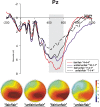Beauty matters: social preferences in a three-person ultimatum game
- PMID: 25951138
- PMCID: PMC4423917
- DOI: 10.1371/journal.pone.0125806
Beauty matters: social preferences in a three-person ultimatum game
Abstract
Preference for beauty is human nature, as previous behavior studies have supported the notion of "beauty premium" in which attractive people were more easily to get promoted and receive higher salaries. In the present study, 29 males were recruited to participate in a three-person ultimatum game (UG) including a proposer, a responder and a powerless third player. Each subject, playing as the responder, had to decide whether to accept an offer from the allocator both for himself and a female third person. We aimed to elucidate how the facial attractiveness of the female subject affected the male subjects' fairness and decision-making in social exchanges. Frontal feedback-related negativity (FRN) in response to four offers in an attractive-face condition revealed no significant differences between offers; however, when the companion was an unattractive female, an "unfair/fair" offer, which assigned a lower share to the responder and a fair share to the third player, elicited the largest FRN. Furthermore, when the third player was offered the smallest amount ("fair/unfair" offer), a larger FRN was generated in an attractive-face condition than unattractive-face condition. In the "unfair/fair" offer condition in which subjects received a smaller allocation than the third person, the beauty of their female counterparts attenuated subjects' aversion to inequality, resulting in a less negative FRN in the frontal region and an increased acceptance ratio. However, the influence of the third player's facial attractiveness only affected the early evaluation stage: late P300 was found to be immune to the "beauty premium". Under the two face conditions, P300 was smallest following an "unfair/fair" offer, whereas the amplitudes in the other three offer conditions exhibited no significant differences. In addition, the differentiated neural features of processing facial attractiveness were also determined and indexed by four event-related potentials (ERP) components: N170, frontal N1, N2 and late positive potentials (LPPs).
Conflict of interest statement
Figures






Similar articles
-
Hello handsome! Male's facial attractiveness gives rise to female's fairness bias in Ultimatum Game scenarios-An ERP study.PLoS One. 2017 Jul 5;12(7):e0180459. doi: 10.1371/journal.pone.0180459. eCollection 2017. PLoS One. 2017. PMID: 28678888 Free PMC article.
-
The undermining effect of facial attractiveness on brain responses to fairness in the Ultimatum Game: an ERP study.Front Neurosci. 2015 Mar 10;9:77. doi: 10.3389/fnins.2015.00077. eCollection 2015. Front Neurosci. 2015. PMID: 25805967 Free PMC article.
-
The impact of facial attractiveness and alleged personality traits on fairness decisions in the ultimatum game: Evidence from ERPs.Biol Psychol. 2024 Jul;190:108809. doi: 10.1016/j.biopsycho.2024.108809. Epub 2024 May 7. Biol Psychol. 2024. PMID: 38718883
-
Beauty premium: Event-related potentials evidence of how physical attractiveness matters in online peer-to-peer lending.Neurosci Lett. 2017 Feb 15;640:130-135. doi: 10.1016/j.neulet.2017.01.037. Epub 2017 Jan 19. Neurosci Lett. 2017. PMID: 28111351
-
A foxy view of human beauty: implications of the farm fox experiment for understanding the origins of structural and experiential aspects of facial attractiveness.Q Rev Biol. 2013 Sep;88(3):163-83. doi: 10.1086/671486. Q Rev Biol. 2013. PMID: 24053070 Review.
Cited by
-
Distinct neural computations scale the violation of expected reward and emotion in social transgressions.Commun Biol. 2025 Jan 21;8(1):106. doi: 10.1038/s42003-025-07561-7. Commun Biol. 2025. PMID: 39838081 Free PMC article.
-
Vocal Attractiveness Matters: Social Preferences in Cooperative Behavior.Front Psychol. 2022 May 26;13:877530. doi: 10.3389/fpsyg.2022.877530. eCollection 2022. Front Psychol. 2022. PMID: 35693505 Free PMC article.
-
Differences in fairness and trust between lean and corpulent men.Int J Obes (Lond). 2016 Nov;40(11):1802-1808. doi: 10.1038/ijo.2016.134. Epub 2016 Aug 3. Int J Obes (Lond). 2016. PMID: 27485913
-
Beauty and Social Interest Matter: Effects of Male's Facial Attractiveness, Vocal Attractiveness and Social Interest on Female's Decisions in Three-Person Games.Behav Sci (Basel). 2024 Dec 2;14(12):1154. doi: 10.3390/bs14121154. Behav Sci (Basel). 2024. PMID: 39767295 Free PMC article.
-
Neural time course and brain sources of facial attractiveness vs. trustworthiness judgment.Cogn Affect Behav Neurosci. 2018 Dec;18(6):1233-1247. doi: 10.3758/s13415-018-0634-0. Cogn Affect Behav Neurosci. 2018. PMID: 30187360
References
-
- Hamermesh DS, Biddle JE. Beauty and the labor market. National Bureau of Economic Research. 1993; 84: 1174–1194.
-
- Solnick SJ, Schweitzer ME. The influence of physical attractiveness and gender on ultimatum game decisions. Organizational behavior and human decision processes. 1999; 79: 199–215. - PubMed
-
- Wilson RK, Eckel CC. Judging a book by its cover: Beauty and expectations in the trust game. Political Research Quarterly. 2006; 59: 189–202.
Publication types
MeSH terms
LinkOut - more resources
Full Text Sources
Other Literature Sources
Miscellaneous

